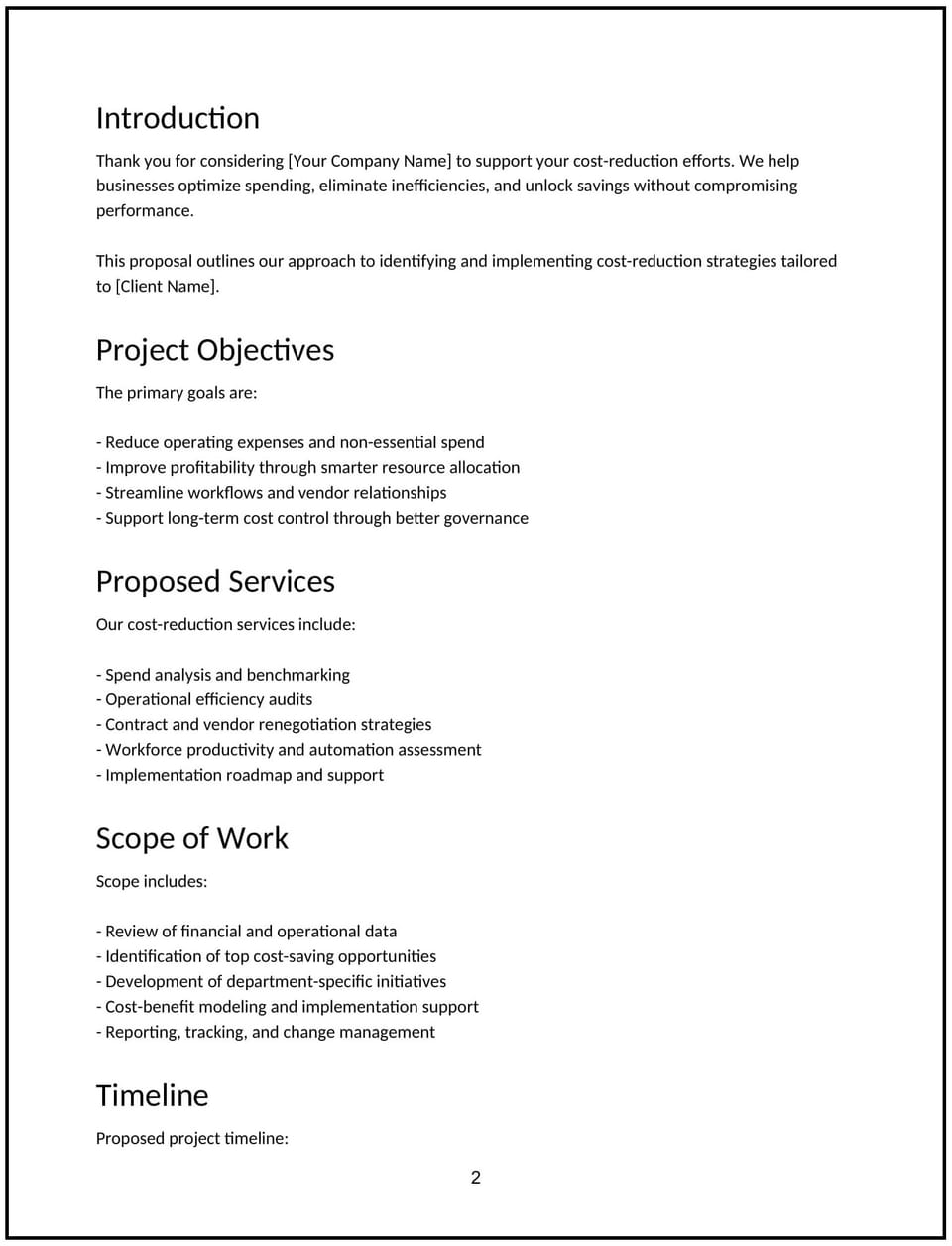Cost reduction proposal: Free template

Customize this free cost reduction proposal with Cobrief
Open this free cost-reduction proposal in Cobrief and start editing it instantly using AI. You can adjust the tone, structure, and content based on your offer, the client’s goals, and their current expense challenges. You can also use AI to review your draft — spot gaps, tighten language, and improve clarity before sending.
Once you're done, send, download, or save the proposal in one click — no formatting or setup required.
This template is fully customizable and built for real-world use — ideal for pitching expense audits, process improvements, or strategic cost-cutting initiatives. Whether you’re creating proposals regularly or occasionally, this version gives you a structured head start and removes the guesswork.
What is a cost reduction proposal?
A cost reduction proposal is a document used to present a plan aimed at identifying and implementing ways to reduce business expenses without sacrificing quality or efficiency. It outlines your analysis of current spending patterns, recommended actions, and expected financial benefits.
Typically shared after initial consultations or audits, this proposal helps stakeholders align on priorities, approaches, timelines, and savings targets.
A good cost-reduction proposal helps you:
- Clearly identify areas with potential cost savings.
- Communicate actionable strategies to reduce expenses.
- Set realistic goals and timelines for implementation.
- Move the client closer to approval and project launch.
Use this proposal when you want to offer a clear, measurable plan to improve financial performance through cost optimization.
Why use Cobrief to edit your proposal
Cobrief gives you a faster, smarter way to customize and polish your proposal directly in your browser — with built-in AI to support your writing.
- Edit the proposal directly in your browser: No setup or formatting required — just click and start working.
- Rewrite sections with AI: Highlight any sentence and choose from smart rewrite options like simplify, rephrase, or change tone.
- Run a one-click AI review: Get actionable suggestions to improve flow, fix vague language, or fill in missing detail.
- Apply AI suggestions instantly: Review and accept individual AI suggestions, or apply all improvements across the proposal in one click.
- Share or export instantly: Send your proposal via Cobrief or download a clean PDF or DOCX file — ready to share with clients.
No formatting headaches, no guessing — just a clean, guided experience from start to finish.
When to use this proposal
This cost reduction proposal works well in scenarios like:
- Conducting expense audits to identify inefficiencies.
- Streamlining operations to reduce overhead costs.
- Negotiating better supplier contracts or payment terms.
- Implementing technology or process automation.
- Preparing for budget tightening or financial restructuring.
Use this proposal when you want to clearly communicate a structured approach to cutting costs sustainably.
What to include in a cost reduction proposal
Each section in this template helps you communicate your offer clearly and professionally. Here's what to include — and how to tailor it:
- Executive summary: Summarize key expense areas and your proposed reduction strategies.
- Analysis and findings: Present your assessment of current spending and pain points.
- Recommendations: Detail specific actions, such as renegotiation, process improvements, or technology adoption.
- Implementation plan and timeline: Outline phases, milestones, and responsible parties.
- Expected savings and impact: Quantify potential cost reductions and business benefits.
- Pricing: Clearly outline your fees and what’s included.
- Terms and conditions: Set payment, scope, and confidentiality terms.
- Next steps: Provide a clear CTA for approval, kickoff, or follow-up discussion.
How to write an effective cost reduction proposal
An effective cost reduction proposal is data-driven, pragmatic, and client-focused. Here’s how to improve yours:
- Use clear data and examples: Reference actual expenses or benchmark figures.
- Focus on achievable savings: Avoid unrealistic or vague promises.
- Explain the impact: Highlight how cost cuts support broader business goals.
- Set transparent timelines: Build trust through realistic scheduling.
- Include contingency plans: Address risks or alternative strategies.
- End with a clear next step: Encourage prompt client action.
Frequently asked questions (FAQs)
How do I tailor this proposal for different industries?
Customize cost categories and savings strategies to match the client’s sector and operational model.
What pricing models work best?
Fixed fees, success-based fees, or phased billing tied to milestones are common.
Can technology solutions be part of the plan?
Yes — process automation or software adoption can feature prominently.
How do I address potential resistance to changes?
Highlight change management support and communication plans in your approach.
Can I export this proposal for client sharing?
Yes. After editing, export a professional PDF or Word document ready for distribution.
This article contains general legal information and does not contain legal advice. Cobrief is not a law firm or a substitute for an attorney or law firm. The law is complex and changes often. For legal advice, please ask a lawyer.